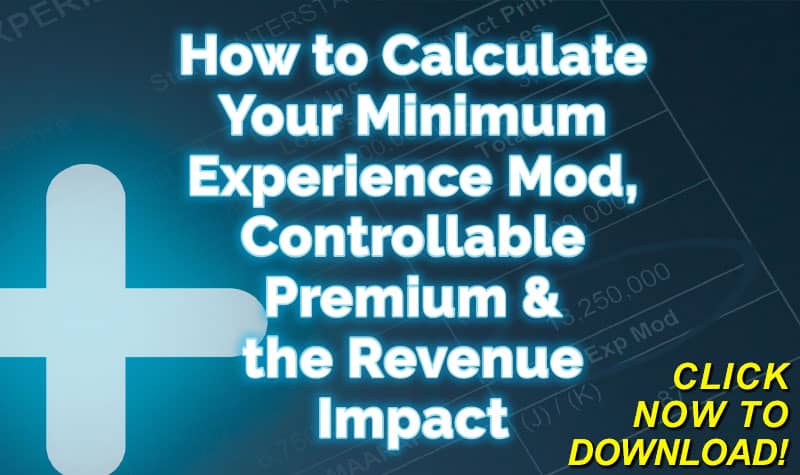TO LEARN MORE ON THIS SUBJECT:
Register for the full on-demand course:
- HOW TO DETERMINE WHICH WORKERS’ COMP INSURANCE STRUCTURE IS RIGHT FOR YOU
Registration – How to Decide Which Insurance Structure is Right For You
How does a company maximize the return on investment of implementing work comp management best practices?
Hello, my name is Michael stack and I’m the CEO of AMAX and the short answer to that question of ‘how does this company maximize their ROI’ is to start with the right insurance structure, whether that be guaranteed cost, or a retro or a captive, high deductible program or self-insurance policy. But the question is how does a company then determine what is the right insurance structure for them? So often I see this done in the marketplace so incorrectly and only a small percentage of the time is this actually done right. Most of the time it’s just sort of done Willy Nilly and you’re just guessing or the insurance broker says, Hey, I’ve got this really awesome retro policy with this XYZ carrier and I think you’re perfect for that.
The Right Insurance Structure for the Right Employer
Or, Hey, I’ve got this really awesome captive because I know captives really well and I specialize in captives and I think everyone should be in a captive and you should be going to captive to. In short, what often happens is that if an insurance broker is a hammer, everyone looks like a nail and if that hammer is a captive program or if that hammer is a high deductible program or if that hammer is a retro program or even if the hammer is a guaranteed cost program, where all you know is guaranteed costs, every single company you look at looks like they should fit into that program, which is not the right way to do it at all. You need to raise yourself up and have a higher level of professionalism in the marketplace to analyze an employer’s needs or if you’re an employer yourself to analyze your own needs and be able to ask the right questions to your insurance broker and risk advisor team.
Click Link to Access Free PDF Download
“How to Calculate Your Minimum Experience Mod, Controllable Premium & the Revenue Impact”
So I want to talk about today is these four cornerstones of risk financing, what they look like and how you start to go about making this decision because when we’re talking about maximizing the return on investment, why are we implementing from a senior management standpoint, why are we doing all this work with return to work? Why are we working and our injury response systems? Why are we working on building out our medical networks and building this adjuster team and building out this partnership with all our whole risk financing, our risk management team? Why are we doing all that stuff? Of course, it’s to impact those injured workers, but particularly from a senior manager standpoint, it’s all about that bottom line and that’s what’s going to fuel, if you hit that bottom line right, then you’ll really be able to fuel that injured worker being able to really take care of them as well.
4 Cornerstones of Risk Financing
Let’s talk about these four cornerstones and what they are, and again, this is how you’re going to go about really starting to make an analyze this decision. I’m going to write these out here first.
These four cornerstones are:
- Risk tolerance
- WC Management Best
- Predictability of your risk
- Financial Impact
So these are the four cornerstones and I’m just going to run through these again very quickly cause this is all about changing the mindset and if you can get out of this video to change your mindset of how you examine this from being a specialist in retro programs where everyone looks like they fit into a retro program, to now being a professional in the marketplace to now determine via these four cornerstones and asking these questions and having this perspective and how you look at this to change up that, how that looks like for you.
Determining Risk Tolerance
Okay, so risk tolerance, how comfortable is an organization with this variability of risk? Are they really risk-averse and they want to be very conservative, they want to be very predictable. We’re going to write a guarantee cost check and we’re going to know that in our budget and that’s going to be solid and we can predict that out and we’re in great shape or can they handle a little bit more variability as far as what’s going to happen with their losses? That’s sort of question number one. What helps you then be more comfortable taking on more risk is these two things right here. These two things are going to help you be more comfortable in taking on more risk. One is if you know, whoops, I wrote best twice there. If you know you’re doing really well in your return to work program, you know you’re doing really well in your injury prevention program, you’ve really cranked that up, you’ve dialed everybody in, you’ve gone through the supervisor training, your supervisors know how to respond to injuries appropriately.
You’ve built out your claims handling team with your adjusters and you’re just cooking with gas. You can take on a lot more risk because you know you that you’ve reduced it on your own side. Same thing with this predictability of risk number. This is a big, big factor in this decision-making process. If you’ve ever going retro or high deductible or kept over self-insured, you start to look at this law of large numbers to say, well, how likely are we to now incur these losses? How likely based on actuarial data, big numbers based on this predictability of losses, how comfortable are we in this section? You’re going to get some help. You’re going to get some help from an actuary most likely to help you have this predictability of risk and the more comfortably without that, the more risk you can take on. So big two pieces here.
And then, of course, the financial impact is understanding that financial impact, both tax implications from your different structures and then that risk-reward feature as well as the more risk that you take on. Obviously, the more reward and organization it’s going to take.
FREE DOWNLOAD: “How to Calculate Your Minimum Experience Mod, Controllable Premium & the Revenue Impact”
Change Perspective of Risk Financing Decision Making
This is a very complex topic as you start to unfold it. And as you start to dig deeper into this. But again, the point of this video today is to change your perspective on how you look at this, to raise up your level of professionalism. To say that this decision is it about the market. This decision is about what’s best for the client, and if you are the client, if you are the employer client to now have these four things, your risk tolerance, how well you’re doing it, management of work comp, the predictability of risks, and then the financial impact on your organization.
Those are the four cornerstones of now you how you start to go about making this right decision to maximize that return on investment and get, my name is Michael stack and the CEO of AMAXX, and remember your work today in workers’ compensation can have a dramatic impact, as we’ve talked about here on your company’s bottom line, but it will have a dramatic impact on someone’s life. So be great.

Author Michael Stack, CEO Amaxx LLC. He is an expert in workers’ compensation cost containment systems and helps employers reduce their workers’ comp costs by 20% to 50%. He works as a consultant to large and mid-market clients, is a co-author of Your Ultimate Guide To Mastering Workers Comp Costs, a comprehensive step-by-step manual of cost containment strategies based on hands-on field experience, and is founder & lead trainer of Amaxx Workers’ Comp Training Center.
Contact: mstack@reduceyourworkerscomp.com.
Workers’ Comp Roundup Blog: https://blog.reduceyourworkerscomp.com/
©2019 Amaxx LLC. All rights reserved under International Copyright Law.
Do not use this information without independent verification. All state laws vary. You should consult with your insurance broker, attorney, or qualified professional.




